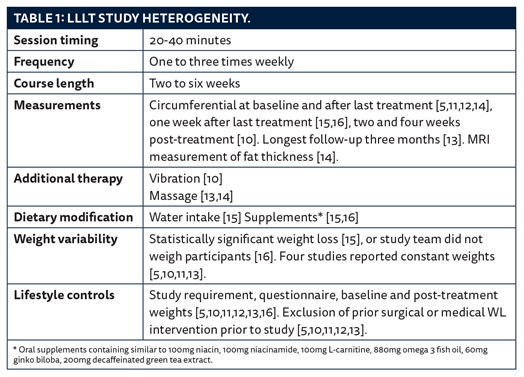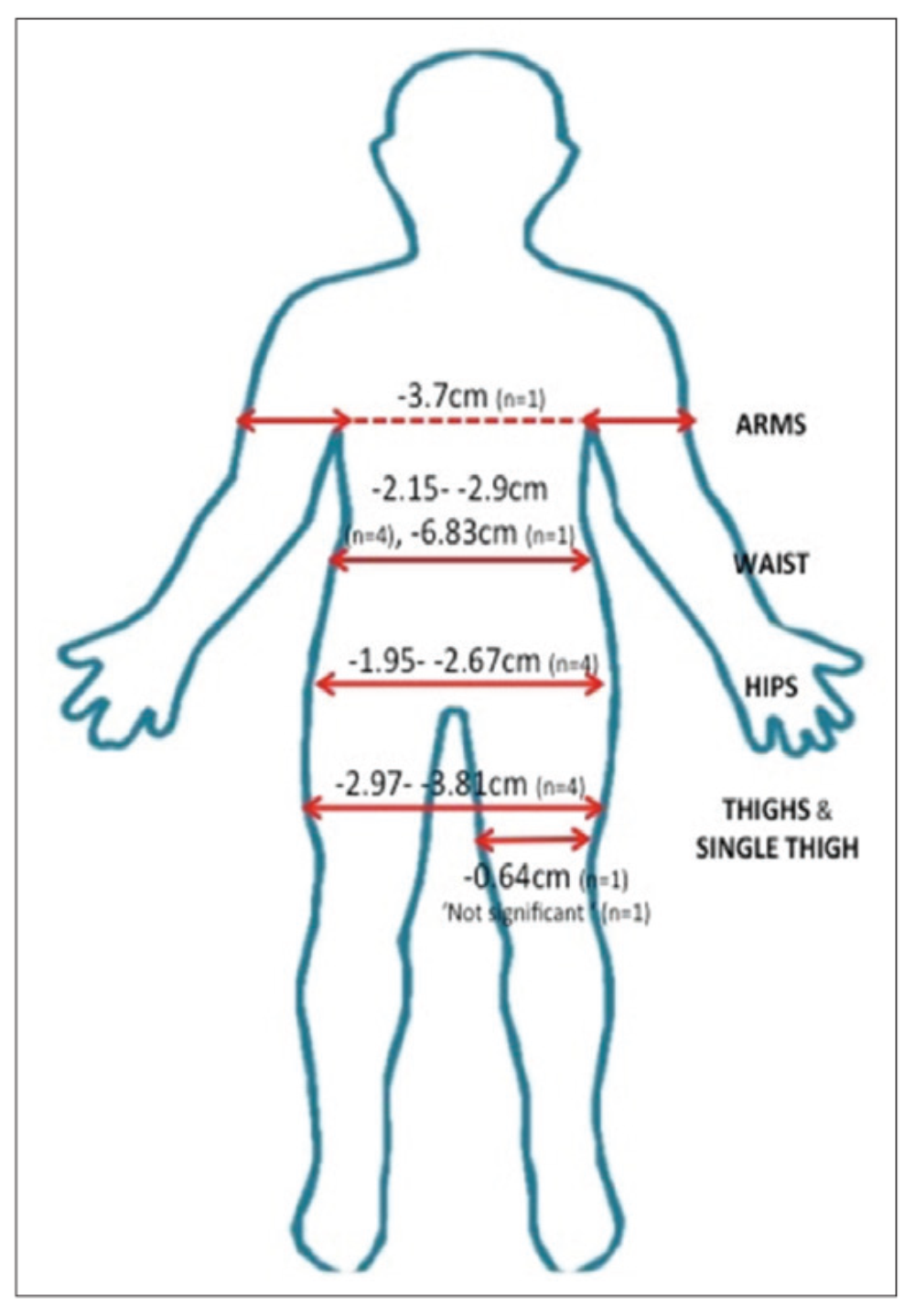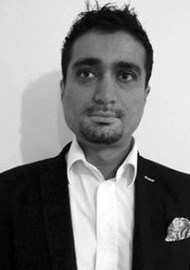Is low level laser the answer for patients seeking a non-invasive method for body contouring?
Balancing energy intake and energy expenditure is the healthiest and most sustainable means of weight loss and toning, but despite this, areas of local fat deposition may persist. Depots of fat in the lower body have been described as efficient at removing fat from the circulation, but resistant to weight loss, in comparison to upper body depots, which are able to discharge fatty acids at a high rate [1].
Microdialysis measurements have shown that considerably greater lipolysis occurs during exercise in subcutaneous abdominal fat compared with gluteal fat [2]. Non-invasive techniques are an appealing option for managing localised adiposity when compared with the potential side-effects, cost and recovery time associated with invasive surgery. There are currently four leading non-invasive techniques for lowering body fat: low level laser therapy (LLLT), cryolipolysis, radiofrequency and high intensity focussed ultrasound (HIFU). This article focuses on LLLT.
Fat storage and metabolism
Adipocytes store excess energy as triacylglycerol. Negative energy balance stimulates lipolysis, resulting in release of glycerol and non-esterified fatty acids (NEFAs) from the adipocyte, with shrinkage and likely apoptosis of adipocytes. NEFAs bind to serum albumin for transport to tissues including muscle and liver. During fasting, the concentration of NEFAs typically increases as fatty acids are released, but chronically high levels of NEFAs are often associated with metabolic dysfunction, type II diabetes and obesity [3].
Low level laser therapy
LLLT causes no demonstrable tissue heating or macroscopic changes in tissue structure [4]. It is believed to act by a photobiological or biostimulatory reaction [5], exciting the photoreceptor cytochrome C oxidase and affecting the cell bioenergetics [6]. Transmission electron microscopic images have demonstrated formation of transitory pores in adipocyte membranes followed by collapse of adipose cells [7]. LLLT appears to stimulate the adipocyte mitochondria, increasing adenosine triphosphate synthesis and up-regulating cyclic adenosine monophosphate, stimulating cytoplasmic lipase, which converts triglycerides into NEFAs and glycerol. These can pass through the pores in the cell membrane [8]. LLLT does not cause necrosis or apoptosis of the adipocyte, unlike HIFU or cryolipolysis [9].
Trial results
In 2015, Kennedy et al. [9] reviewed the clinical outcomes of non-invasive fat reduction devices. Thirty-one studies involving 2937 patients were identified, including 1114 patients treated with LLLT. Nearly all studies were performed on non-obese (BMI<30) subjects, 15-84 years of age. The LLLT studies comprised six prospective clinical studies [5,10-14] and two retrospective reviews [15,16]. Significant heterogeneity inhibits accurate comparison of results. The varying characteristics are outlined in Table 1.


Figure 1: Mean circumferential reductions (n = number of studies) after LLLT at the
arms, waist, hips, thighs and single thigh, data from Kennedy et al [9].
Efficacy
Most studies assessed improvements at the waist and / or thighs. Mean circumferential reductions in studies reviewed by Kennedy et al. [9] are depicted in Figure 1. All except one study [14] produced statistically significant circumferential reductions. The largest reductions occurred in Savoia et al. [10], in which LLLT was combined with vibration therapy to treat 33 patients, with one treatment per week for six weeks. The largest measured reductions were seen at the end of the treatment, with no adverse events (abdomen and flanks -6.83cm, thighs -3.42cm, buttocks -6.16cm). The choice of additional therapy seems relevant as Gold et al. [13] produced a lesser but still significant -0.64cm (p<0.05) reduction in one thigh after two sessions per week for four weeks of LLLT plus massage.
It is possible that duration and frequency of treatments, and course length, do not significantly impact on the overall results. The study with the highest frequency and longest individual treatment time, Jackson et al. in 2012 [16], delivered 40-minute sessions three times weekly for two weeks to 689 patients, resulting in waist -2.9cm, hip -2.41cm, thighs -3cm, and -0.81cm for each arm. However, with the same frequency and course length, but treatment time of 20 minutes, Jackson et al. in 2009 [12] also produced significant results at the waist -2.49cm, hip -2.67cm and thighs -3.81cm, and with 30-minute sessions twice weekly for four weeks Caruso et al. [5] also produced significant reductions at the waist of -2.15cm.
LLLT produced good patient satisfaction at 80% [11], compared with cryolipolysis at 73-100% satisfaction, radio frequency (RF) at 71% and 97%, HIFU at 47.5-85% [9]. However, Lach [14] recorded patient satisfaction at just 31.9% after LLLT to a single thigh, with a non-significant decrease in thigh circumference.
Longevity
There is little data on the longevity of LLLT therapy. Kennedy et al. [9] describe fat reaccumulation occurring more quickly after LLLT than HIFU or cryolipolysis, which is thought to be due to the differing effect on the adipocyte. Gold et al. [13] reported a maintained significant reduction in thigh circumference at one month, with some reduction maintained to three months, compared with a patient control.
Side-effects
Kennedy et al. [9] reported that LLLT had the fewest and mildest side-effects out of the non-invasive techniques. Thirty-eight percent of LLLT subjects described swelling or erythema at the treated area, 32% had pain or tingling during treatment, and increased urination was also reported.
Discussion
LLLT can produce statistically significant reductions in body circumference measurements in non-obese patients, with minimum side-effects. Results are noticeable as soon as treatment is over, whereas HIFU and RF results are generally seen over 4-12 weeks [9], but the results diminish over the following months.
Savoia et al. [10] found that, after the entire study protocol, serum triglycerides (esterified fatty acids) and very low-density lipoprotein (VLDL) levels were mildly decreased, and liver function was not affected [10]. However, despite evidence that NEFAs are released [8], and availability of the blood test [17], the levels of NEFAs post-procedure have not been measured. Caruso et al. [5] estimate that the amount of fat mobilised with a single lipolaser treatment is a mean of 52g. It was felt that this amount of fat could be consumed in a large meal, and if the weight of the subjects was stable, the mobilised fat would be metabolised or distributed into fat depots typical of their fat distribution. It was suggested that the laser sessions should add no more risk of atherosclerosis than the routine eating of meals. UK health guidelines [18] recommend that the average man should eat no more than 30g of saturated fat a day and the average woman no more than 20g.
During negative energy balance, fat stores are released and metabolised for energy. Redistribution of fat using laser interventions does not change the body’s lipolytic thresholds, and so in LLLT, fat stores are being released with no requirement for extra energy. This would increase the level of circulating NEFAs for an uncertain duration of time, before re-deposition at their original or an alternative body site. Savoia et al. [10] noted this was especially likely to happen in the absence of a healthy lifestyle. Another concern is the site of fat re-deposition, as ‘central’ fat deposition is considered less healthy than subcutaneous. When subjects undergoing abdominal surgery were given isotopically labelled fatty acids and biopsies of fat depots taken at surgery 24 hours later, the accumulation of label was most marked at omental and retroperitoneal depots [19].
Health supplements such as niacin, niacinamide, L-carnitine, omega 3 fish oil, ginko biloba, decaffeinated green tea extract [15,16] are intended to stimulate fat metabolism, though their impact is not well known. The use of additional physical therapies may enhance efficacy and have health benefits, such as vibration therapy, which is thought to promote metabolism of lipid by stimulating skeletal muscle and vascular and lymphatic drainage [10]. Due to heterogeneity it is uncertain whether the combination of LLLT and vibration in Savoia et al. [10] explains their superior circumferential results, but complementing LLLT with additional treatment and / or encouragement to promote metabolism seems healthier for the patient and may produce the best and most sustainable results.
References
1. Jones PR, Edwards DA. Areas of fat loss in overweight young females following an 8-week period of energy intake reduction. Ann Hum Biol 1999;26:151-62.
2. Arner P, Kriegholm E, Engfeldt P, Bolinder J. Adrenergic regulation of lipolysis in situ at rest and during exercise. J Clin Invest 1990;85:893-8.
3. Steffen BT, Steffen LM, Zhou X, et al. Fatty acids attenuate the risk of diabetes associated with elevated serum nonesterified fatty acids: the multi-ethnic study of atherosclerosis. Diabetes Care 2015;38(4):575-80.
4. King PR. Low level laser therapy: a review. Lasers MedSci 1989;4:141.
5. Carouso-Davis MK, Guillot TS, Podichetty VK, et al. Efficacy of low level laser therapy for body contouring and spot fat reduction. Obes Surg 2011;21:722-9.
6. Yu W, Naim JO, McGowan M, et al. Photomodulation of oxidative metabolism and electron chain enzymes in rat liver mitochondria. Photochem Photobiol 1997;66:866-71.
7. Neira R, Arroyave J, Ramirez H, et al. Fat liquefaction: effect of low level laser energy on adipose tissue. Plast Reconstr Surg 2002;110:912-22.
8. Karu TI. Mitochondrial signalling in mammalian cells activated by red and near-infrared radiation. Photochem Photobiol 2008;84:1091-9.
9. Kennedy J, Verne S, Griffith R, et al. Non-invasive subcutaneous fat reduction: a review. J Euro Acad Dermatol Venerol 2015;29:1679-88.
10. Savoia A, Landi S, Vannini F, et al. Low-level laser therapy and vibration therapy for the treatment of localized adiposity and fibrous cellulite. Dermatol Ther (Heidelb) 2013;23:3(1):41-52.
11. Nestor MS, Newburger J, Zarraga MB. Body contouring using 635-nm low level laser therapy. Semin Cutan Med Surg 2013;32:35-40.
12. Jackson RF, Dedo DD, Roche GC, et al. Low-level laser therapy as a non-invasive approach for body contouring: a randomized, controlled study. Lasers Surg Med 2009;41(10):799-809.
13. Gold MH, Khatri KA, Hails K, et al. Reduction in thigh circumference and improvement in the appearance of cellulite with dual-wavelength, low-level laser energy and massage. J Cosmet Laser Ther 2011;13:13-20.
14. Lach E. Reduction of subcutaneous fat and improvement in cellulite appearance by dual-wavelength, low-level laser energy combined with vacuum and massage. J Cosmet Laser Ther 2008;10:202-9.
15. McRae E, Boris J. Independent evaluation of low level laser therapy at 635nm for non-invasive body contouring of the waist, hips and thighs. Lasers Surg Med 2013;45:1-7.
16. Jackson RF, Stern FA, Neira R, et al. Application of low level laser therapy for non-invasive body contouring. Lasers Surg Med 2012;44:211-7.
17. Alpha Laboratories. Non-esterified free fatty acids NEFA HR-2 Assay Reagent 1 manufactured by Wako Chemicals. www.alphalabs.co.uk
18. NHS Choices. Fat: the facts. 2015. www.nhs.net
19. Mårin P, Andersson B, Ottosson M, et al. The morphology and metabolism of intra-abdominal adipose tissue in men. Metabolism 1992;41:1242-8.
Declaration of competing interests: None declared.
TAKE HOME MESSAGE
-
LLLT can produce rapid reduction in body circumference, in non-obese patients with minimum side-effects.
-
LLLT may be seen as an effective adjunctive therapy for stubborn areas of fat deposition in patients leading an active and healthy lifestyle, rather than a quick fix for weight loss in sedentary patients (no, don’t quit the gym!).
-
Further studies: the effect of LLLT on circulating NEFA levels and their sites of re-deposition needs more study. In addition the role of adjuvant therapies to enhance NEFA metabolism which could prolong the circumferential reduction and result in healthier patients is a ripe area for further research.
COMMENTS ARE WELCOME






